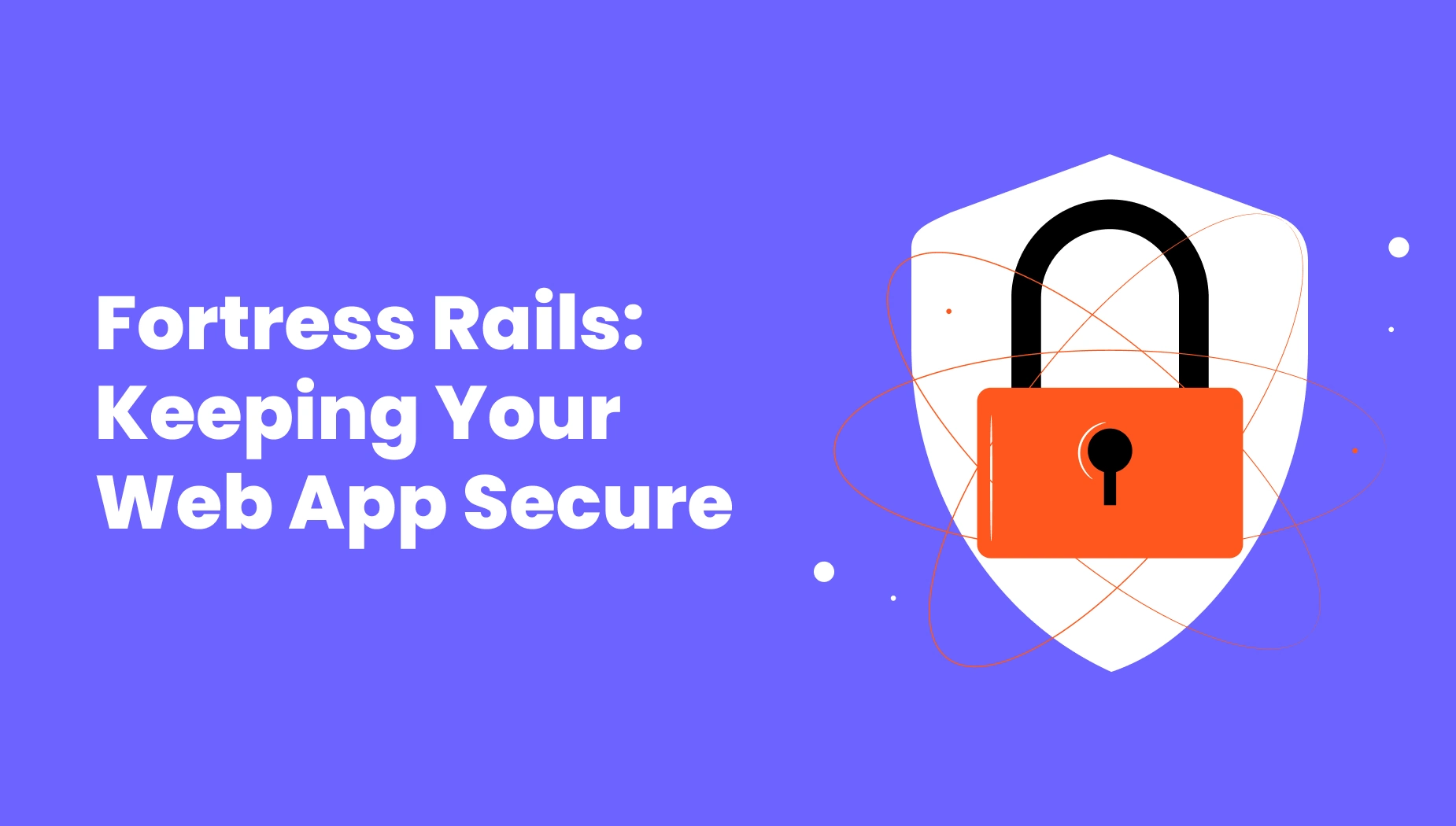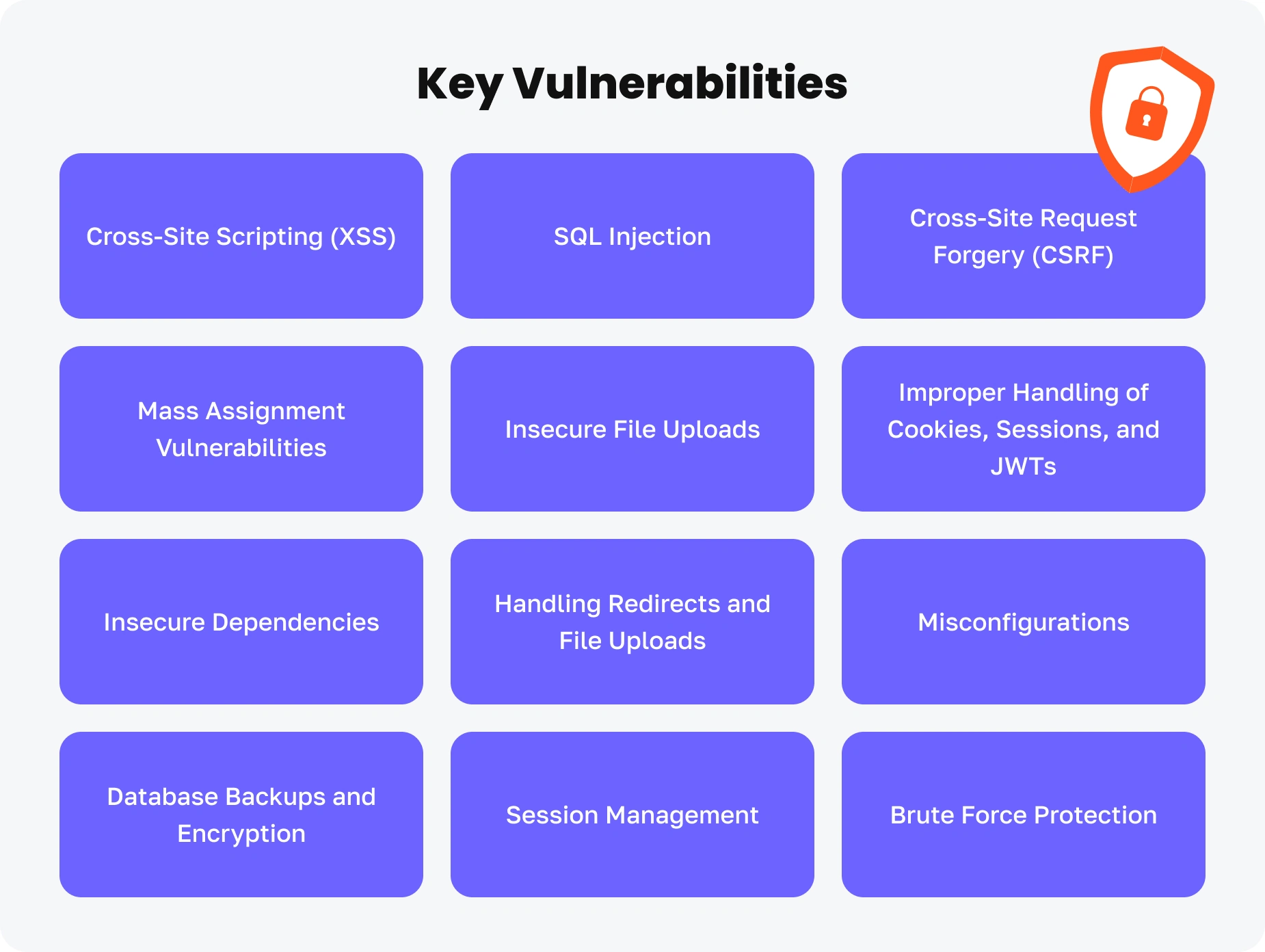Table of Contents
Ruby on Rails (Rails) is a popular web application framework known for its efficiency and simplicity. However, like any technology that powers web applications, it’s vulnerable to security threats. Protecting your Rails application from these threats is crucial, especially as web applications become frequent targets of cyberattacks.
Managing Change, Access, and Compliance
When building a Rails application, the level of security you implement often depends on the type of data you manage and any regulatory standards you must comply with, such as handling customer health records (HIPAA compliance) or financial records (PCI DSS compliance). In such cases, strict change management, Software Development Life Cycle (SDLC), and Separation of Duty (SOD) practices are crucial to ensure the integrity and confidentiality of your data.
Key Measures
Access Control
Rails offers built-in tools for securely storing sensitive data, such as API keys and database credentials, in encrypted formats. This ensures that even if a system administrator or developer gains access to your environment, they cannot view or misuse critical information, such as your database passwords. You can implement strict Access Control Lists (ACLs) by carefully managing access to specific resources. For instance, database administrators (DBAs) should not have access to server SSH keys, while system administrators should be restricted from accessing source control repositories like Git. This segregation of duties minimizes the risk of unauthorized access and significantly reduces the likelihood of accidental or intentional data breaches.
Multi-Factor Authentication (MFA)
To safeguard your systems from unauthorized access, enforcing Multi-Factor Authentication (MFA) is crucial. Fortunately, the Ruby community offers robust libraries like Devise and OmniAuth, enabling developers to integrate advanced authentication methods into their applications easily. These highly customizable tools make it straightforward to implement MFA for sensitive systems. This ensures that even if login credentials are compromised, attackers still cannot gain access without passing additional verification steps.
Logging and Monitoring
Rails comes equipped with high-quality logging tools designed to meet common security requirements right out of the box. These tools ensure that all access attempts and system changes are thoroughly recorded. Additionally, they can be easily adapted to integrate with major log storage and analysis platforms, providing comprehensive insight into your application’s activity. By combining Rails’ logging capabilities with real-time monitoring systems like SIEM (Security Information and Event Management), you can swiftly detect and respond to suspicious activities, ensuring your team is always alert and prepared to handle potential security incidents.
Secure Development Practices
Rails offers a comprehensive set of tools to enhance security throughout the development process. By leveraging static code analysis and dependency vulnerability scanning, you can proactively identify potential security issues in your codebase and external libraries. These tools help ensure that vulnerabilities are detected and resolved before they can be exploited.
Additionally, Rails supports secure user interactions through built-in features and libraries that help prevent common security risks, such as input validation, session management, and protection against attacks like XSS and SQL injection. With these mechanisms in place, you can ensure that your application upholds high-security standards in all user interactions, significantly reducing the risk of vulnerabilities.
Integrating Compliance and Security
Incorporating these practices into your Rails application development improves security and ensures compliance with industry-specific regulations, like GDPR or CCPA. These proactive measures help mitigate insider threats, reduce the risk of data breaches, and maintain regulatory compliance.
Why Security Matters in Ruby on Rails Applications
As web applications increasingly handle sensitive data, their security becomes paramount. Failure to protect that data can lead to severe consequences, including:
- Data Theft
Compromised user information can result in identity theft, financial fraud, or corporate espionage. - Financial Loss
Downtime, lost customers, or hefty fines from regulatory bodies can severely impact a business’s bottom line, not to mention the breach mitigation costs. - Reputational Damage
A single data breach can permanently erode user trust, leading to brand credibility loss and customer loyalty. - Legal Implications
Non-compliance with data protection regulations like GDPR, HIPAA, or PCI DSS can result in massive fines, potentially bankrupting smaller organizations.
Key Vulnerabilities and How They Are Prevented
Cross-Site Scripting (XSS)
XSS attacks occur when attackers inject malicious scripts into your web pages. These scripts can hijack user sessions, steal sensitive data, or manipulate user interactions.
| Vulnerability | Ruby on Rails | Java (Spring) | PHP (Yii) | Python (Django) |
|---|---|---|---|---|
| Cross-Site Scripting (XSS) | Offers built-in protection through automatic output escaping, which significantly reduces the risk with minimal developer intervention. | Requires manual encoding to prevent XSS attacks, which increases the chance of errors. | Lacks automatic protection, requiring developers to manually encode content, increasing the risk of oversight. | Provides automatic output escaping similar to Rails but requires more effort for a streamlined process. |
Rails offers superior default protection against XSS, reducing the risk of vulnerabilities compared to other frameworks where manual interventions are more frequent.
SQL Injection
SQL injection allows attackers to manipulate input data to execute unauthorized SQL commands, potentially compromising or deleting sensitive data.
| Vulnerability | Ruby on Rails | Java (Spring) | PHP (Yii) | Python (Django) |
|---|---|---|---|---|
| SQL Injection | Prevents SQL injection by default with its ORM, ensuring safer data handling. | Requires manual implementation of protection methods, increasing the risk if not done correctly. | Offers basic protection but requires developers to be cautious when using raw SQL queries. | Generally prevents SQL injection well, but Rails provides a more secure and straightforward approach. |
Rails provides one of the most secure and straightforward methods for preventing SQL injection, resulting in fewer vulnerabilities than Spring and Yii.
Cross-Site Request Forgery (CSRF)
CSRF attacks manipulate users into unintentionally performing actions by exploiting the trust a web application places in the user’s browser.
| Vulnerability | Ruby on Rails | Java (Spring) | PHP (Yii) | Python (Django) |
|---|---|---|---|---|
| CSRF | Offers automatic CSRF protection with default token inclusion in forms. | Requires configuration to enable CSRF protection. | CSRF protection is available but must be manually implemented, increasing the chance of errors. | Includes CSRF protection by default, but requires additional setup for certain API configurations. |
Rails provides more straightforward and reliable CSRF protection, making it easier to prevent vulnerabilities compared to frameworks like Spring and Yii
Mass Assignment Vulnerabilities
Mass assignment vulnerabilities occur when attackers can update sensitive attributes by passing unexpected parameters, like changing user roles or permissions.
| Vulnerability | Ruby on Rails | Java (Spring) | PHP (Yii) | Python (Django) |
|---|---|---|---|---|
| Mass Assignment | Uses structured parameters that prevent attackers from assigning values to sensitive fields. | Relies on a manual validation process, which increases the complexity of preventing mass assignment. | Provides basic control but is prone to mistakes due to manual handling. | Provides some tools to manage this, but Rails offers a more intuitive and foolproof solution. |
Rails provides a more structured and foolproof solution for mass assignment prevention, reducing the risk of accidental exposure compared to other frameworks.
Insecure File Uploads
Improperly handling file uploads can allow attackers to upload malicious files, which can then be executed on your server or downloaded by unsuspecting users.
| Vulnerability | Ruby on Rails | Java (Spring) | PHP (Yii) | Python (Django) |
|---|---|---|---|---|
| File Upload Security | Offers easy-to-use tools for validating and securely storing file uploads, ensuring security. | Requires manual configuration, increasing the risk of misconfiguration. | Provides basic file validation but lacks robust built-in security tools. | Offers solid file handling but requires more manual work compared to Rails. |
Rails provides a more comprehensive and developer-friendly approach to secure file uploads, reducing vulnerabilities compared to other frameworks.
Improper Handling of Cookies, Sessions, and JWTs
Improper management of cookies, sessions, and JSON Web Tokens (JWTs) can lead to data leakage or unauthorized access.
| Vulnerability | Ruby on Rails | Java (Spring) | PHP (Yii) | Python (Django) |
|---|---|---|---|---|
| Improper Handling of Cookies, Sessions, JWTs | Encrypts cookies and sessions by default, with additional security features that are easy to configure. | Requires manual configuration for secure handling, adding complexity. | Requires manual implementation of secure session and token handling. | Provides secure session management, but Rails offers a more straightforward and integrated approach. |
Insecure Dependencies
Using third-party libraries (gems) can introduce vulnerabilities if they contain flaws or are not regularly updated.
| Vulnerability | Ruby on Rails | Java (Spring) | PHP (Yii) | Python (Django) |
|---|---|---|---|---|
| Insecure Dependencies | Provides tools to monitor and update dependencies easily, reducing the risk of using insecure libraries. | Requires frequent auditing and manual checks for insecure dependencies. | Lacks integrated tools for managing dependencies, increasing risk. | Offers tools to audit dependencies but lacks the seamless integration seen in Rails |
Misconfigurations
Misconfigured settings, especially in production environments, can expose sensitive information or make your application vulnerable to attacks.
| Vulnerability | Ruby on Rails | Java (Spring) | PHP (Yii) | Python (Django) |
|---|---|---|---|---|
| Misconfigurations | Provides secure default settings, including encryption for sensitive data, reducing the risk of misconfigurations. | Misconfigurations are more likely due to fewer secure defaults. | Has a higher risk of misconfigurations because of the lack of centralized secure defaults. | Provides good production defaults but lacks the ease of Rails in managing sensitive data. |
Database Backups and Encryption
Databases are prime attack targets, particularly when backups are not encrypted or securely stored.
| Vulnerability | Ruby on Rails | Java (Spring) | PHP (Yii) | Python (Django) |
|---|---|---|---|---|
| Database Backups and Encryption | Ensures secure data handling with encrypted connections and data encryption at rest and in backups. | Requires manual configuration for encryption and backup security. | Relies on manual encryption, increasing the risk of oversight. | Offers tools for encryption, but Rails has a more streamlined and integrated approach. |
Session Management
| Vulnerability | Ruby on Rails | Java (Spring) | PHP (Yii) | Python (Django) |
|---|---|---|---|---|
| Session Management | Provides strong session management, including mechanisms to reset sessions and enforce SSL easily. | Requires manual session management setup, which increases the chance of errors. | More prone to session management issues due to manual handling. | Provides good session handling, but Rails is more comprehensive and easier to use. |
Handling Redirects and File Uploads
| Vulnerability | Ruby on Rails | Java (Spring) | PHP (Yii) | Python (Django) |
|---|---|---|---|---|
| Handling Redirects and File Uploads | Validates redirects and uploads securely with built-in tools for validation. | Requires manual validation of redirects and uploads, increasing the risk of vulnerabilities. | Provides basic tools but lacks the robust built-in options of Rails. | Offers strong file handling, but Rails’ ecosystem is more integrated and easier to work with. |
Brute Force Protection
| Vulnerability | Ruby on Rails | Java (Spring) | PHP (Yii) | Python (Django) |
|---|---|---|---|---|
| Brute Force Protection | Provides tools for rate limiting and CAPTCHA integration, making brute force protection simple. | Requires external libraries or manual setup for brute force protection. | Lacks strong out-of-the-box brute force protection and requires manual rate limiting. | Offers tools like django-axes, but Rails offers an easier and more integrated approach. |
Unique Vulnerabilities and Overall Prevention
Ruby on Rails
Rails handles many security concerns automatically, from escaping HTML to managing SQL injection and CSRF, which reduces the potential for vulnerabilities. Even issues like YAML deserialization are rare and easily preventable with safe practices.
Java (Spring)
The flexibility of Spring can be a double-edged sword, leading to more frequent vulnerabilities like XXE injections if not configured securely. Developers need to be more vigilant to prevent such issues.
PHP (Yii)
Yii’s security depends heavily on the developer’s discipline. Common vulnerabilities like Remote File Inclusion (RFI) can emerge if input validation is neglected.
Python (Django)
While Django is secure by design, Rails offers a more comprehensive and less error-prone approach to handling vulnerabilities, making it easier for developers to prevent issues without deep security expertise.
Additional Best Practices for Securing Ruby on Rails Applications
Use HTTPS Everywhere
Always enforce HTTPS in your application to ensure data is encrypted in transit, preventing attackers from intercepting sensitive information.
Regularly Conduct Security Audits
Perform periodic security audits and penetration testing to identify and address vulnerabilities before attackers exploit them.
Implement Logging and Monitoring
Set up comprehensive logging and monitoring to detect unusual activity or potential attacks. Use tools like ELK Stack, Papertrail, or Datadog to monitor logs and receive alerts for suspicious activities.
Limit the Use of Third-Party Gems
Only include gems essential for your application and have a good reputation for security. The more dependencies you have, the greater your potential exposure to vulnerabilities.
Minimize Data Exposure
Avoid storing sensitive data unless necessary, and ensure that sensitive information is encrypted in transit and at rest.
Leveraging Ruby on Rails Security Tools and Gems
Rails provides tools and gems to strengthen your security posture, such as Brakeman, Bundler Audit, Devise, and SecureHeaders
Building a Security-First Mindset in Your Development Team
Building secure applications requires fostering a security-first culture through regular training, integrating security into CI/CD pipelines, and conducting regular security audits and penetration testing.
Why Ruby on Rails Leads in Secure Web Development?
Ruby on Rails has fewer inherent vulnerabilities than many other languages and frameworks, due to its built-in security features and developer-friendly approach to mitigating common risks. It offers more automatic protections and guides developers to follow best practices, significantly reducing the risk of introducing vulnerabilities. This makes Rails safer and more efficient for building secure web applications, especially compared to the manual effort required in Spring, Yii, and Django.
Securing your Ruby on Rails application requires a proactive and comprehensive approach. Implementing best practices such as escaping user input, validating user data, and employing secure authentication methods significantly reduces the risk of breaches. Security is not a one-time task but an ongoing process that requires continuous vigilance, regular audits, dependency checks, and a security-first mindset to protect your application effectively.
You can build a robust, resilient Ruby on Rails application that safeguards user data, maintains trust, and withstands evolving cyber threats by integrating security into every development phase.





